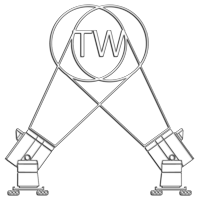| Name |
Description |
#books |
| Bandolier |
A pocketed belt for holding ammunition usually slung sash-style over the shoulder, with the ammunition pockets across the midriff and chest. | 1 |
| Bangalore torpedo |
An explosive charge placed within one or several connected tubes. It is used by combat engineers to clear obstacles that would otherwise require them to approach directly under fire. | 1 |
| Breda 30 |
The standard light machine gun of the Royal Italian Army during World War II. The dust and sand of the deserts of North Africa resulted in a combination of premature wear and higher rates of jamming. | 2 |
| Breda carrier |
A vehicle used as a carrier of the Breda Machine-Gun that was mounted on the back pointing rearwards. | 1 |
| Bren Gun |
A series of light machine guns adopted by Britain in the 1930s. Best known for its role as the British forces’ primary infantry light machine gun in WW2. | 8 |
| Flame-thrower |
A mechanical incendiary device designed to project a long, controllable stream of fire. They were used during World War I, and more widely in World War II. Some project a stream of ignited flammable liquid; some project a long gas flame. | 3 |
| Flare Guns |
A firearm that launches flares and is typically used for distress signalling. It is not designed to function as a weapon. The most common type is the Very pistol. | 6 |
| Flare |
A type of pyrotechnic that produces a brilliant light or intense heat without an explosion. They are used for signalling, illumination, or defensive countermeasures in civilian and military applications. | 11 |
| Hand Grenade |
Any small bomb that can be thrown by hand. A variety of hand grenades exist, the most common being explosive grenades designed to detonate after impact or after a set amount of time. Grenadiers were originally soldiers who specialised in throwing grenades. | 4 |
| Lewis Gun |
A initially WW1 era light machine gun of US design that was perfected and mass-produced in the UK, and widely used by British troops serving up to the end of the Korean War. | 2 |
| Machine gun |
A fully automatic mounted or portable firearm, usually designed to fire bullets in quick succession from an ammunition belt or magazine. | 16 |
| MP 40 submachine gun |
A German submachine gun using the 9×19mm Parabellum cartridge used extensively by the Axis powers during WW2. Although designed in 1938 by Heinrich Vollmer, it was often called 'Schmeisser' by the Allies, after Hugo Schmeisser, who designed the previous MP 18. | 1 |
| No. 82 grenade |
A British hand grenade used during WW2 also known as a 'Gammon Bomb' after its designer. It consisted of an elasticized stockinette bag made of dark coloured material, a metal cap, and a fuze. The explosive charge wrapped in fabric was sewn to an impact fuse that detonated on sharp contact. | 1 |
| Rifle |
A firearm designed to be fired from the shoulder, with a barrel that has a helical groove or pattern of grooves cut into the barrel walls. | 10 |
| Spandau 'Machine Gun' |
A nickname originally applied to refer to the MG 08, the German Army's standard machine gun in WW1 produced in the Spandau Arsenal. Also later erroneously used by WW2 allied troops to reference the later MG 34/MG 42 German recoil-operated air-cooled general-purpose machine guns. | 2 |
| Sten gun |
A family of British submachine guns which were used extensively by British and Commonwealth forces throughout WW2 and the Korean War. They had a simple design, a very low production cost and over four million were made in the 1940s in various versions. | 1 |
| Thompson submachine gun |
An American submachine gun, invented by John T. Thompson in 1918 and adopted by the U.S. military in 1938. Also used by the British. | 6 |
| Tracer ammunition |
A bullet or cannon caliber projectile built with a small pyrotechnic charge in their base. This makes the projectile trajectory visible during daylight, and very bright during nighttime firing. | 10 |

